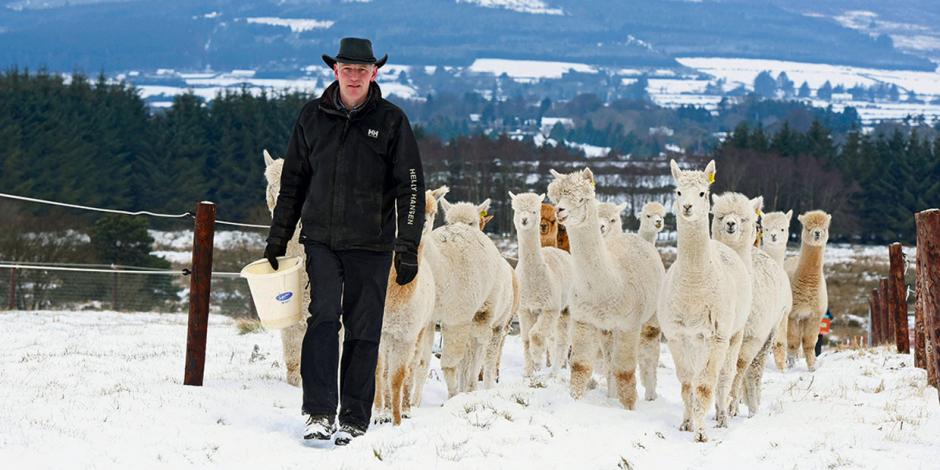My name is Joe Phelan and I’m 60 years old. I’m a retired banker turnedehemalige(r)...und ...turned alpaca farmer. I live with a herd of 90 alpacas on a 90-acreMorgenacre farm in County Wicklow, Ireland.
I bought my farm a year ago. It was completely derelictverfallenderelict, so I’m to jugglehier: unter einen Hut bringenjuggling a big restoration project with farming and my agritourism business.
My day generally begins before 7 a.m. and doesn’t end until 11 p.m. or later. I don’t mind the long hours. Everything I do is determined by the animals. Their welfareWohlergebenwelfare comes first. This means that the criaJungtier (von Kamelartigen)cria I’m to hand-feedvon Hand aufziehenhand-feeding at the moment gets his breakfast before I do. Once I’ve checked on the animals, I start into the paperwork. Administration takes up a lot of my time.
Alpacas are native to South America and found in Peru, Bolivia and Chile. There are about 2,500 in Ireland. An alpaca stands at about 1.2 metres and weighs around 90 kilos. They come in many colours, from chocolate brown and black to sandy brown and white.
I’m to be passionate about sth.eine Leidenschaft für etw. habenpassionate about alpacas. They’re friendly and curiousneugierigcurious, and each one has its own personality. I love being close to these beautiful animals and introducing people to them through our treks. They also make ideal therapy animals, and we to runhier: durchführenrun regular sessions for those with autismAutismus-Spektrum-Störungautism and other special needs.
Everything I do is determined by the animals
Most people come here to experience trekking with an alpaca by their side. A trek experience lasts about two hours and each person leads their own animal across the farm and through the forest. We go at a leisurely paceTempopace. This means it’s a suitable activity for all ages. We don’t do the treks every day, as I like to rest the animals in between. We give people a little talk about alpacas before they start, and they get the opportunity to feed them and to take lots of selfies.
Looking after the animals takes up a lot of time. They get regular health checks, and sometimes, if one of them is unwell, the vetTierarzt, Tierärztinvet comes. Depending on the time of year, we may be busy with new arrivals. The mothers usually give birth in the mornings and manage well on their own most of the time. Sometimes, things don’t go to plan and they need help. For example, we might have to hand-feed a baby if its mother is not producing enough milk.
The alpacas are to shearscherenshorn every year and that’s a big job. They produce fibre rather than wool. It’s naturally warm, fire- resistant, hypoallergenic and, because of its structure, also to repelabwiesen, abperlen lassenrepels water. We send the yarn to England for processing. The long fibre is made into socks, hats, gloves, scarves and knitting wool. The short fibres are made into pillows, duvetBettdeckeduvets and mattress toppers.
What I love about my job is that no two days are the same. It’s labour-intensive, but having worked in an office for 39 years, every day in the open air feels like a day off. If you love what you do, you’ll never actually work a day in your life.
Neugierig auf mehr?
Dann nutzen Sie die Möglichkeit und stellen Sie sich Ihr optimales Abo ganz nach Ihren Wünschen zusammen.



